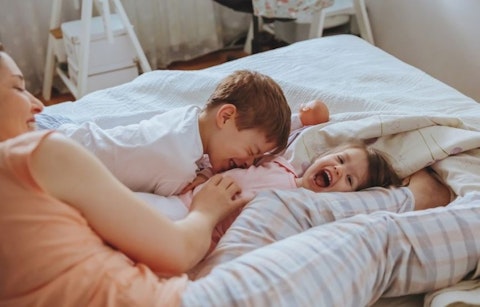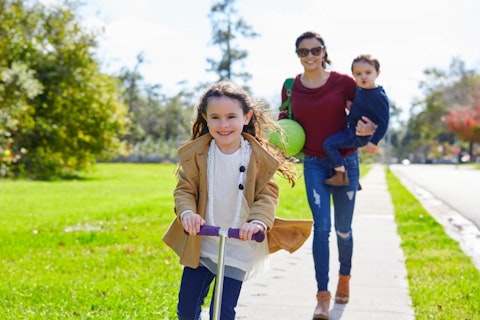If you’re planning on starting a family soon, you’ll want to check out our article on the easiest age gap between babies: 5 research studies.
It obviously takes a lot of planning (or it should at least) when it comes to having kids and starting a family. Some people like to have all their kids back-to-back, while others would rather space them out and take their time. However you want to do it, it might be good to have a plan ahead of time. I’m the youngest of three kids and by some standards, way younger than my sisters. There’s an almost nine year age gap between me and my oldest sister, and almost six years between the middle sister and me. They’re a little closer (with a three year gap) in age and definitely spent more of their younger years together than with me. I didn’t mind being so much younger than my siblings because it gave me more time with just my parents than they had. Once they were off to college, I was left at home and got to piggyback on my parent’s work trips, which allowed me to see a lot of the country. And now that we’re all older, and adults, we have no problem getting along and understanding one another.

Copyright: dobledphoto / 123RF Stock Photo
However, the gaps between ages of your kids can pose different issues no matter how small or large the gap. Siblings are basically always going to fight. According to KidsHealth, “kids’ needs at different ages affect how they see and connect with each other.” Consulting several resources such as The Alpha Parent, Baby Center, Parenting and Aha!Parenting, we came to the conclusion that different age gaps can also have different physical and mental affects on the mother. This really makes sense the younger your kids are. For instance a newborn brings its own mountain of challenges, but if you also have a toddler, you’ll be in for a lot of stressful and sleepless nights ahead. On the other hand, these sources point out the possible jealousy that can occur when you have an older child and a much younger child. If you really want to make your kid mad, name them something from this list of 10 most evil scariest names for male and female babies. However, to help you plan (and also help everyone to get along) we took a look at some research studies that focused on age gaps.
To come up with our list, we took the sources from the above mentioned sites and added The New York Times, and WHO reports. We then took the most popular studies we found and ranked them by year in which they were published. We would like to note that “easiest” age gaps depends on people’s experiences and preferences and there is no way to really quantitate what’s easiest in this case.
Without further ado, let’s take a look at some of the easiest age gap between babies: 5 research studies.
5. Number of Siblings, Sibling Spacing, Sex and Birth Order: Their Effects of Perceived Parent-Adolescent Relationships by Jeannie Kidwell
Date: 1981
Based on this research, age spacing influences mental condition, especially when it comes to the first child. In this case, participants showed a negative view of both themselves and their parents once a sibling was born as long as the older child was at least two years old. On the other hand, siblings younger than that, don’t really notice a new sibling. For an age gap of more than four years old, kids didn’t seem to be affected.

SaMBa/Shutterstock.com
4. Report of a WHO Technical Consultation on Birth Spacing
Date: 2005
We are continuing our list of the easiest age gap between babies: 5 research studies with this report that suggests that families wait at least 2 years between having children. They say this lowers the health risks for the mother and the next child. In their opinion, the ideal age gap is 3-5 years. Research also found that women who wait at least 59 months to have the next child face a higher risk for pre-eclampsia.

Andrey_Popov/Shutterstock.com
3. Institute for Social and Economic Research, University of Essex
Date: 2006
-model: 1.503 families (3, 532 individuals)
This study of about 1,500 families showed that 16% of first born siblings who had a four year or lower age gap with the next sibling(s) were more ambitious. This study believes the best age gap is about four years and comes in at number three on our list of easiest age gap between babies: 5 research studies.

Garnet Photo/Shutterstock.com
2. Birth Spacing and Children’s outcome
Date: March 2011
This 2011 study, mainly focused on how age gaps affected educational achievements between siblings. They also based their findings on children’s (ages 5-7) scores on the Peabody Individual Achievement Test. They found that a larger gap improves the health of both mom and infants, longer spacing between kids showed higher test scores for the older ones, but lower scores for the younger ones.

holbox/Shutterstock.com
1. Mayo Clinic Research
Date: 2017
Because this is the most recent study, it comes in at number one on our list. This Mayo Clinic study reported that an age gap of less than 6 months resulted in a higher risk of premature birth, as well as a number of mental disabilities, and less than two years of a gap increased the risk of autism. They suggest parents wait at least two years before having kids, for a lower risk of birth defects and health issues.

Monkey Business Images/Shutterstock.com
Now that you know the science behind age gaps in siblings, we hope you enjoyed learning from this list of easiest age gap between babies: 5 research studies.





